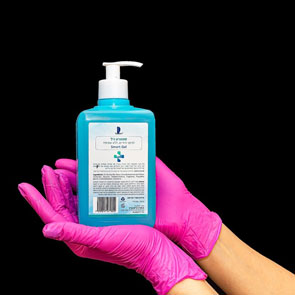How to Make Your Own Hand Sanitizer
 Due to the coronavirus pandemic, hand sanitizer is hard to come by these days. And while washing your hands with soap regularly and thoroughly is a better way to protect yourself from the infection than using sanitizer, you may found yourself in a situation where sanitizer is your only option. That’s why our tips on making DIY hand antiseptic may come in handy.
Due to the coronavirus pandemic, hand sanitizer is hard to come by these days. And while washing your hands with soap regularly and thoroughly is a better way to protect yourself from the infection than using sanitizer, you may found yourself in a situation where sanitizer is your only option. That’s why our tips on making DIY hand antiseptic may come in handy.The most important thing about making your own hand sanitizer is to make sure it contains the right concentration of alcohol. According to the Centers for Disease Control and Prevention, in order to be effective, a hand sanitizer must contain at least 60% alcohol, which is true for store-bought sanitizers (this means that using vodka as sanitizer is not an option, since it’s only 40% alcohol).
Other ingredients that your DIY sanitizer may contain include other antiseptic agents (for example, hydrogen peroxide), glycerin or aloe vera (to soften the skin and prevent its dehydration), essential oils to mask the smell of alcohol, etc. You should be careful with essential oils though because they can cause an allergic reaction.
WHO-recommended Hand Sanitizer
The World Health Organization released a guide for making hand sanitizer back in 2010. Its key active ingredient is ethanol or isopropyl alcohol. Other ingredients include glycerin (used as humectant), hydrogen peroxide (to inactivate bacterial spores in the solution) and cold boiled or distilled water.
To make 1 liter of hand sanitizer, you need to pour 830 ml ethanol (96%) into a 1 l plastic bottle. Add 42 ml hydrogen peroxide (3%) and 15 ml glycerin. Top up the bottle with water, screw the cap and shake gently. Pour the sanitizer into its final containers (for example, 50 ml spray bottles or empty liquid soap bottles). Let it sit for 72 hours before use.
Hand Sanitizer with Aloe Gel
If you don’t have glycerol, you can use aloe vera gel as emollient. It will take care of your hands and keep them from getting dry and flaky. The recipe also calls for essential oil that will mask the smell of alcohol and enhance the antibacterial and antifungal properties of sanitizer, but if you’re hypersensitive or allergic to essential oils, you can forego it.
Mix 3 parts isopropyl alcohol (rubbing alcohol) with 1 part aloe vera gel, add a few drops of tea tree, eucalyptus, peppermint or lavender essential oil and stir well to combine. Pour the solution into its final containers and use as often as needed. It is very important to maintain the ratio of alcohol to aloe vera gel, otherwise the concentration of alcohol in your sanitizer will be too low.
Disclaimer: hand sanitizer IS NOT a substitute for proper hand washing. DIY hand sanitizer recipes – except for the WHO-recommended formulation – have not been tested in a laboratory for efficacy against SARS-CoV-2.
Bonus: DIY Disinfectant Spray and Floor Disinfectant
The new coronavirus can survive on various surfaces for hours and even days, so it’s very important to keep your house or apartment clean. Since alcohol can damage varnished and painted surfaces, homemade disinfectants are usually made with other active ingredients, such as vinegar or chlorine.
To make a DIY disinfectant spray, pour 1 cup white vinegar, ¾ cup borax, 10 drops of lavender oil and 5 drops of lemon oil into a plastic spray bottle, shake to combine. To clean a surface, spray the solution onto it and let it sit, then wipe with a cloth.
To wash and disinfect your floors, try the following recipe. In a large bowl, combine 2 cups warm water, ¼ cup white vinegar, 5-10 drops of any essential oil and 3 drops of dish soap. Stir well and pour into a plastic spray bottle. Shake the bottle before use and spray on the floor, then wipe it with a mop.
Please keep in mind that you must never combine alcohol-based and chlorine-based disinfectants!